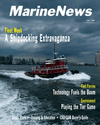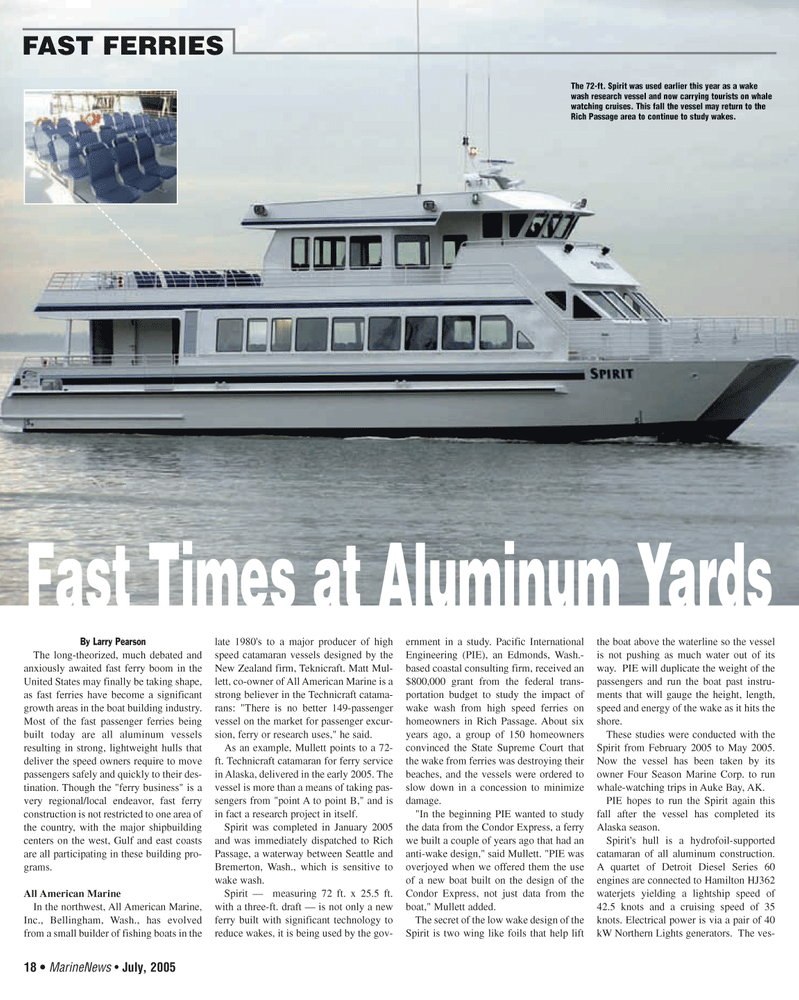
Page 18: of Marine News Magazine (July 2005)
Read this page in Pdf, Flash or Html5 edition of July 2005 Marine News Magazine
By Larry Pearson
The long-theorized, much debated and anxiously awaited fast ferry boom in the
United States may finally be taking shape, as fast ferries have become a significant growth areas in the boat building industry.
Most of the fast passenger ferries being built today are all aluminum vessels resulting in strong, lightweight hulls that deliver the speed owners require to move passengers safely and quickly to their des- tination. Though the "ferry business" is a very regional/local endeavor, fast ferry construction is not restricted to one area of the country, with the major shipbuilding centers on the west, Gulf and east coasts are all participating in these building pro- grams.
All American Marine
In the northwest, All American Marine,
Inc., Bellingham, Wash., has evolved from a small builder of fishing boats in the late 1980's to a major producer of high speed catamaran vessels designed by the
New Zealand firm, Teknicraft. Matt Mul- lett, co-owner of All American Marine is a strong believer in the Technicraft catama- rans: "There is no better 149-passenger vessel on the market for passenger excur- sion, ferry or research uses," he said.
As an example, Mullett points to a 72- ft. Technicraft catamaran for ferry service in Alaska, delivered in the early 2005. The vessel is more than a means of taking pas- sengers from "point A to point B," and is in fact a research project in itself.
Spirit was completed in January 2005 and was immediately dispatched to Rich
Passage, a waterway between Seattle and
Bremerton, Wash., which is sensitive to wake wash.
Spirit — measuring 72 ft. x 25.5 ft. with a three-ft. draft — is not only a new ferry built with significant technology to reduce wakes, it is being used by the gov- ernment in a study. Pacific International
Engineering (PIE), an Edmonds, Wash.- based coastal consulting firm, received an $800,000 grant from the federal trans- portation budget to study the impact of wake wash from high speed ferries on homeowners in Rich Passage. About six years ago, a group of 150 homeowners convinced the State Supreme Court that the wake from ferries was destroying their beaches, and the vessels were ordered to slow down in a concession to minimize damage. "In the beginning PIE wanted to study the data from the Condor Express, a ferry we built a couple of years ago that had an anti-wake design," said Mullett. "PIE was overjoyed when we offered them the use of a new boat built on the design of the
Condor Express, not just data from the boat," Mullett added.
The secret of the low wake design of the
Spirit is two wing like foils that help lift the boat above the waterline so the vessel is not pushing as much water out of its way. PIE will duplicate the weight of the passengers and run the boat past instru- ments that will gauge the height, length, speed and energy of the wake as it hits the shore.
These studies were conducted with the
Spirit from February 2005 to May 2005.
Now the vessel has been taken by its owner Four Season Marine Corp. to run whale-watching trips in Auke Bay, AK.
PIE hopes to run the Spirit again this fall after the vessel has completed its
Alaska season.
Spirit's hull is a hydrofoil-supported catamaran of all aluminum construction.
A quartet of Detroit Diesel Series 60 engines are connected to Hamilton HJ362 waterjets yielding a lightship speed of 42.5 knots and a cruising speed of 35 knots. Electrical power is via a pair of 40 kW Northern Lights generators. The ves- 18 • MarineNews • July, 2005
FAST FERRIES
Fast Times at Aluminum Yards
The 72-ft. Spirit was used earlier this year as a wake wash research vessel and now carrying tourists on whale watching cruises. This fall the vessel may return to the
Rich Passage area to continue to study wakes.
JULYMN2005 3(17-24).qxd 6/30/2005 12:10 PM Page 18

 17
17

 19
19
